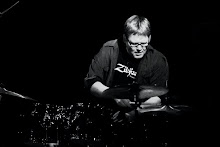I struggled with playing rubato (playing without a steady pulse in the music) for many years.
I think my experience was typical because so much of the playing drummers usually do is about maintaining a pulse (sometimes against all odds!)
So just like soloing, I think we need to work on playing without a strict tempo on our own, because we often don't get a chance on gigs.
Here's a few things I've learned.
1) Don't abandon musicality just because you've abandoned tempo
I really used to not listen and just play a bunch of nonsense in rubato situations. Often there's no tempo in "free" or as I would prefer, "open form" music.
However all the normal principles apply. Be very aware of dynamics, thickness or thinness of sonic textures, who is in the foreground of the music at any given point, the shape of the piece (does it have a beginning, middle, and end?) What is the overall mood (joyous, angry, sad, humourous?) and what can we do to represent that mood etc.
Now sometimes people will play rubato on a standard tune. In that case much of the work is done for us in terms of the melody and phrases but another point about that is.....
2) Be willing to take charge sometimes
Often with rubato playing (especially with a preexisting tune) it can sound like everyone's waiting for everyone else, and nothing kills it quicker than that.
You want to be sensitive, and not just mow your way over everything, but you also want to realize that not all the beginnings and endings of phrases will line up with the rest of the band, and that actually is part of what makes it sound cool sometimes.
Listen to Paul Motian's trio with Frisell and Lovano to hear how great they are at keeping things moving.
3) Sometimes the effect comes from several pulses at once, rather than no pulse
Again, Motian's band is brilliant at this. I'll have some recommendations and examples at the end.
4) Learn from other styles and instruments
Classical players are taught to use the pulse as a means of expression rather something to be strictly adhered to. (A way of learning that can often cause problems for them when they do play a music with a strict pulse.)
Again, drummers aren't naturally very good at this.
I have a sad confession to make. Until I was in University I didn't understand that most Classical music was played in tempo. I didn't really hear it that way because I wasn't used to the looser way they play the pulse.
Yes, you can say something like, "That's not swinging", but that's missing the point. It grooves in a different sort of way and we can learn from musics that are looser with the pulse rather than being slaves to it.
5) Play textures of different drum grooves, just not always at the same speed
If we play gentle, sweeping sounds with brushes, it's still going to sound like a ballad even though it's not a steady tempo.
Try this with all sorts of grooves Rock, Samba, Cascara, Swing, etc. Also try to use the amount of space in the groove to suggest a tempo, even though you're not playing one strictly. (The great Rashied Ali was brilliant at this. Andrew Cyrille too!)
6) Work on loosening up your strict pulse playing too
The looser you can play in time, the more it will help you see possibilities even when you're not playing in tempo. It's funny, sometimes it's hard to tell at the beginning's of paul Motian trios recordings whether they're playing in time or not because their time playing is so loose and their rubato playing is so logical, yet groovy.
7) As always, listen to infinity... and beyond!
Listen and watch examples of great drummers doing this to help you with the concept.
Speaking of examples , here's Coltrane and Rashied Ali from "Interstellar Space'. The composition is "Jupiter".
Most of the Coltrane rubato stuff (even when it's duo) is very thick, texture wise. it sort of feels like waves of sound that crest, crash against the shore, and then build up again. When I'm attempting to play music like this, one of the main things I'm trying to do is create variety within these thick textures. Other good Coltrane examples are, "Expression", "Ascension", and "Meditations".
Here's the aforementioned Paul Motian Trio
Notice in this case, even though it's an agressive tune as well, there is more space in it than the Coltrane example, and how Motian keeps a texture of timekeeping even though he isn't playing a strict pulse. Also, he often limits the sonic palette (notice he's generally right hand on cym. left hand on snare) to give everything a context.
And here's a gentler tune with Motian playing brushes (and sort of playing a tempo at one point)
I would also recommend the great recording "Time and Time Again" for more great examples for this trio's out of time playing.
Also check out Bartok's string quartets (and play along with them)
Keith Jarrett's American and European 70s bands (they also both play a mean tempo groove as well). Anything with Han Bennink is great too as well as any of the Albert Ayler stuff with Sunny Murray. Try "Unit Structures" by Cecil Taylor to hear Andrew Cyrille play beautiful textures.
I remember seeing a Joey Baron clinic where I asked him a very convoluted question about playing out of tempo (as he is also an expert at this) and his response was simply "Play the music.". Sage advice.
So remember not to get hung up about rubato playing and just think about it as another way of expression yourself musically.

No comments:
Post a Comment